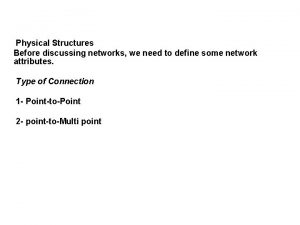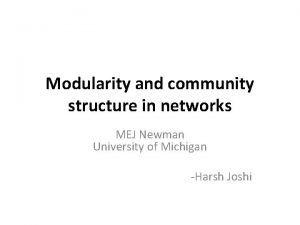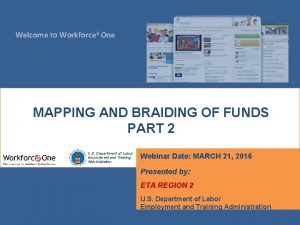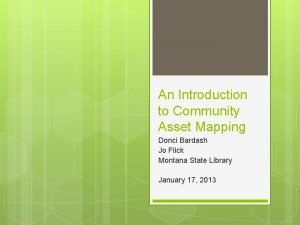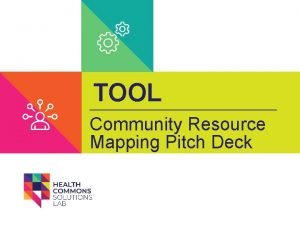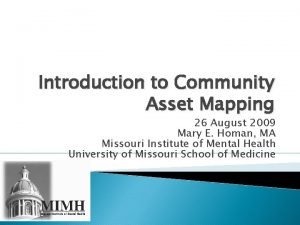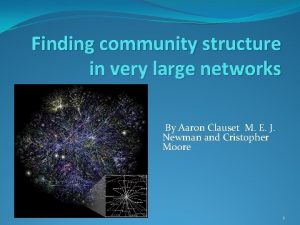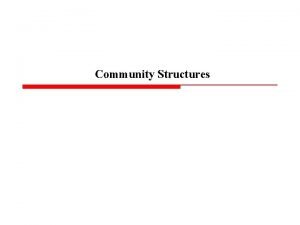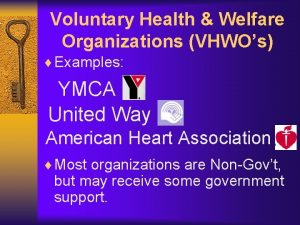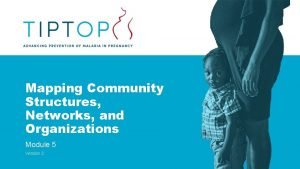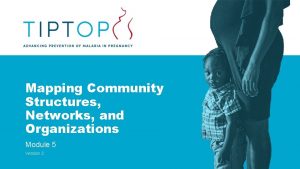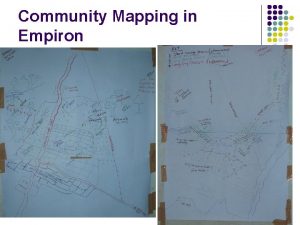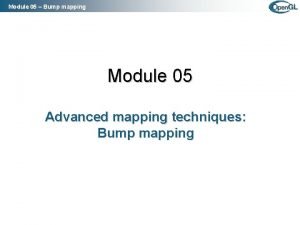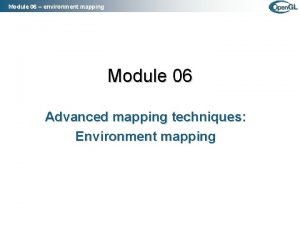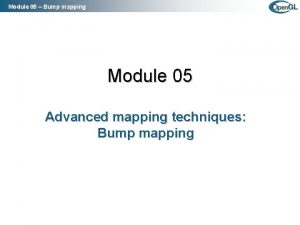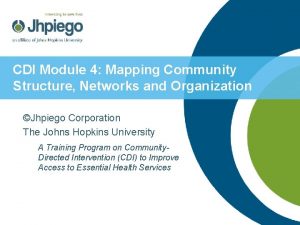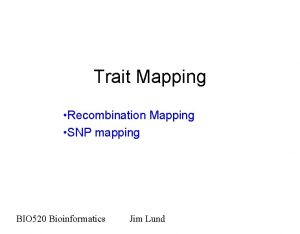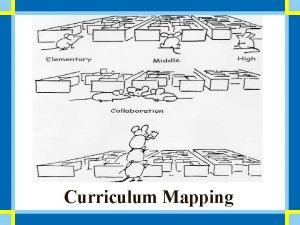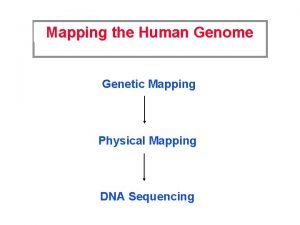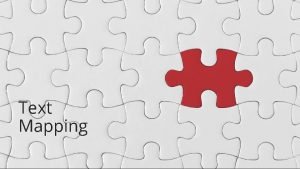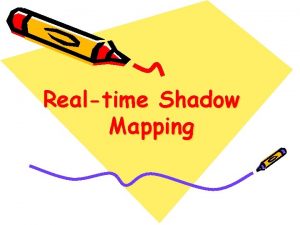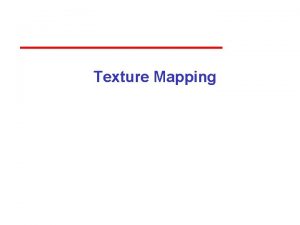Mapping Community Structures Networks and Organizations Module 5





















- Slides: 21

Mapping Community Structures, Networks, and Organizations Module 5 Version 2

Learning objectives • By the end of this module, learners will be able to: • Define the term “community” in the context of “community-directed interventions (CDIs)” • Describe the purpose of community mapping in building support and solving problems • Explain the value of involving community members in mapping their own community • List the steps and activities needed to map the organizations and resources in a community • Facilitate a community census • Use and update the village register of pregnant women 1

Community in the context of CDI • In CDI, we create a strong community-clinic linkage • We start our definition of community by identifying all the settlements, villages, etc. , that are served by a primary health care facility (catchment area) • To make CDI effective, we work with each of the smallest functional units of a community (such as a kindred, clan, neighborhood, hamlet) 2

Mapping • Mapping is: • A very important component of almost all practical situation assessments • A joint activity with the community that can help everyone involved learn more • All programs need to have a sense of where: • People live (especially pregnant women who may be eligible for community-directed intermittent preventive treatment in pregnancy) • Problem areas are • Community resources are located • Others are doing their activities 3 Source: Wiki. How. 2018. How to draw a map of an imaginary place. Wiki. How website. https: //www. wikihow. com/ Draw-a-Map-of-an-Imaginary-Place. Accessed September 25.

Mapping is not just about locations • When community members are involved in mapping, they learn more about the problems and resources in their community • They can visualize service quality issues like access and equity What can you tell about the community from this map? 4 Source: Bill Brieger, Jhpiego

Map health and development resources • Ask people: • To name and describe the location of key health and development resources that the community values, such as: • • • 5 Healers Opinion leaders Medicine shops Local associations, etc. About major subdivisions (e. g. , wards, communities, kindreds/clans, and settlements)

Components of mapping • During the CDI orientation and facilitation meeting, the CDI focal person should: • Learn about the community’s past development efforts and why these did or did not succeed: • Past efforts provide lessons on how to undertake future efforts more successfully • During the community-wide meeting, community representatives should: • Take notes during the meeting • Ask the group to list key persons and organizations in the community that can help promote the program • Identify any potential roadblocks or people who might oppose the program 6

Resource and social mapping • Locating physical structures: • Health facilities and providers • Schools, religious institutions • Boundaries • Understanding social relationships: • Existing organizations, associations, societies, and levels of activity • Wards (subdistricts), kinship groups • Utilization patterns and barriers • Communities are built from their social networks 7 Source: Wiki. How. 2018. How to draw a map of an imaginary place. Wiki. How website. https: //www. wikihow. com/ Draw-a-Map-of-an-Imaginary-Place. Accessed September 25.

Why do we need social mapping? • In mapping, we are interested in our target population, for example: • Pregnant women • People pregnant women turn to for advice and assistance • Key members of social networks to which pregnant women belong • Mapping helps link people in need with the services and resources they need 8

Social mapping helps make sense • Mapping provides useful tools for making sense of social networks and behaviors related to using services during pregnancy • In this case, we are interested in: • The size of the population group we are targeting (for communitydirected intermittent preventive treatment in pregnancy, it’s pregnant women) • Their utilization behaviors • The places and persons they go to for help • What attracts them to these people and places 9

Map resources for women • Specifically ask about resources—people and organizations—that pregnant women go to for advice and help, for example: • Where do they get advice? • Are there women who regularly deliver babies, such as health care workers or traditional birth attendants? Women’s groups in Nigeria. Photos by Karen Kasmauski. 10

Map resources for women, cont. • Where do they get medicines? • From whom do they get financial, emotional, and other support? • Identify women’s associations and support groups 11

Chart the mapping results for malaria in pregnancy Community resource Names of women leaders Names of community subsections (e. g. , kindreds/clans, settlements) Names and locations of health resources— public, private, indigenous Names of key women’s social groups Other special resources for pregnant women 12 Specific examples

If there is time, actual maps can be drawn and kept with the community • A subcommittee led by the CDI focal person can conduct the mapping exercise • Subcommittee members can: • Take a walk around the community • Note the locations of community resources and pregnant women • Translate the notes to: • Community map of resources • Register of pregnant women 13

Use the community mapping information • Encourage community members to use the information generated to help plan program development, for example: • Develop criteria for the best types of people to serve as community health workers—specifically, for malaria in pregnancy programming • Identify subcommunities (e. g. , kindreds/clans, settlements, neighborhoods) from which community health workers could be selected 14

Mapping varies by type of community • Many factors influence a community’s structure, organization, and networks, such as: • The status and concentration of the services in the area • Whether it is urban or rural • The way people utilize the services that are available 15

Rural and urban communities Some rural characteristics: • Greater community cohesion and identity • Smaller and more dispersed units • Seasonal habitations (e. g. , farm hamlets) • Generally poorer Some urban characteristics: • Weaker community identity and cohesion • More compact, but people travel far for work and social needs • Financial gain often supersedes other social needs • Greater divide between poverty and wealth Can you think of other examples? 16

Discussion—A look at other issues • Let’s think of another health issue, for example: • Community management of child illness • Food security • Home-based care for people with HIV • What are the community resources we would need to find and map for these issues? 17

Chart the results for another health issue Community resource Names of leaders Names of community subsections (e. g. , kindreds/clans, settlements) Names and locations of health resources— public, private, indigenous Names of key social groups Other special resources 18 Specific examples

Summary and conclusions • Community members’ involvement in mapping can help them learn more about problems and resources in their community • Mapping lets community members more easily visualize service issues like access and equity • Community participation in mapping makes community landmarks and identity more visible • Mapping helps link people in need with the services and resources they need 19

Thank you! Any questions or comments? 20
 Euler
Euler Difference between virtual and datagram circuit
Difference between virtual and datagram circuit Homologous structures
Homologous structures Memory parameters
Memory parameters Forward mapping vs backward mapping
Forward mapping vs backward mapping Terjemahan
Terjemahan Backbone networks in computer networks
Backbone networks in computer networks Module 11 studying the brain and older brain structures
Module 11 studying the brain and older brain structures Physical structures in computer networks
Physical structures in computer networks Community detection in networks
Community detection in networks C device module module 1
C device module module 1 Community asset mapping examples
Community asset mapping examples Community asset mapping examples
Community asset mapping examples Community resource mapping template
Community resource mapping template An introduction to community asset mapping
An introduction to community asset mapping Finding community structure in very large networks
Finding community structure in very large networks Community structure means
Community structure means Power and politics in organizations
Power and politics in organizations Voluntary health and welfare organizations examples
Voluntary health and welfare organizations examples Floral shops bookstores and farms are examples of
Floral shops bookstores and farms are examples of Formal groups fulfill both and functions in organizations.
Formal groups fulfill both and functions in organizations. Communicating in teams and organizations
Communicating in teams and organizations








